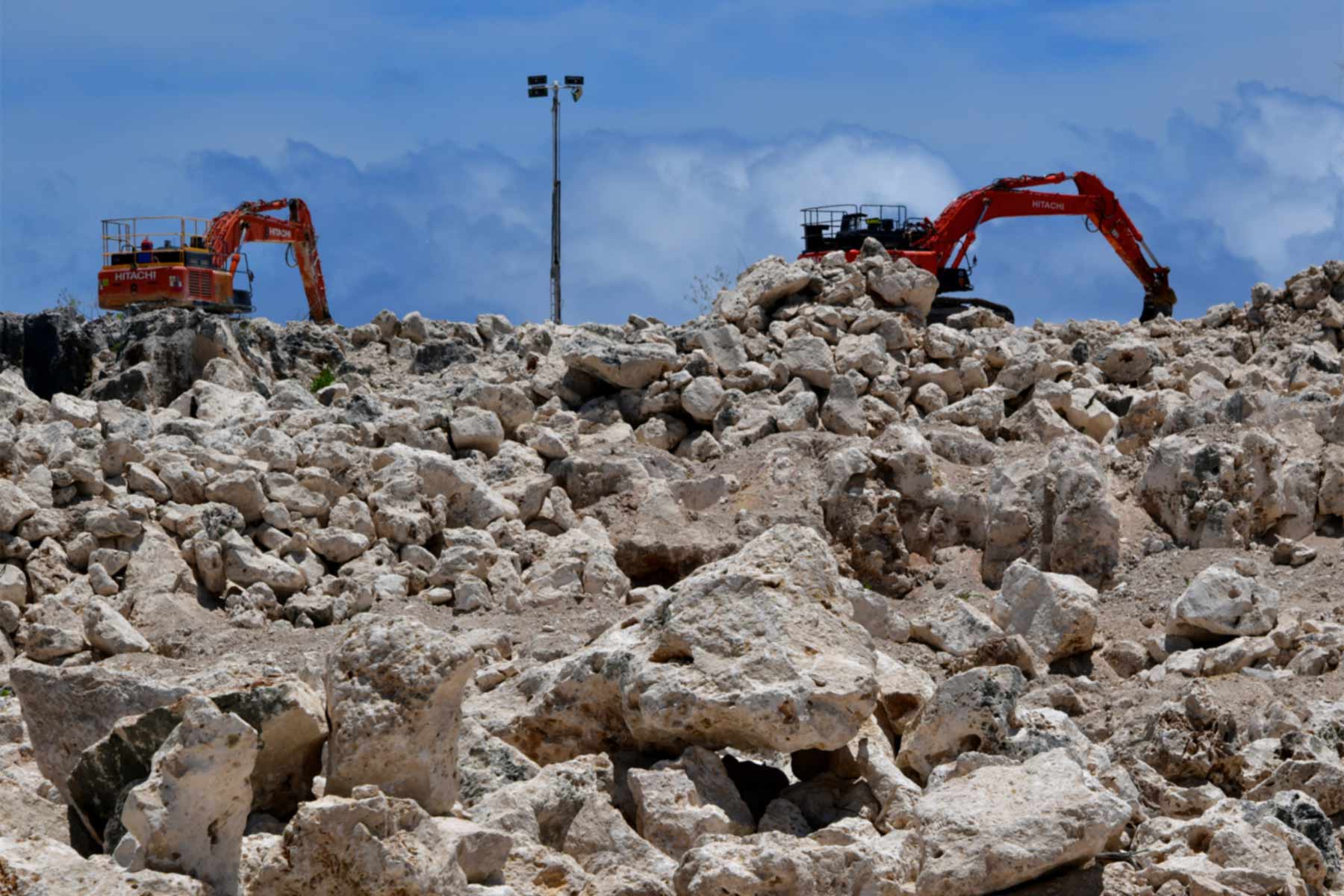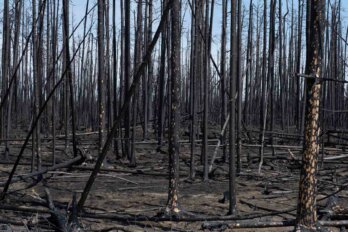Once a tropical paradise on Earth, the world’s smallest island nation of Nauru has been transformed into an uninhabitable moonscape of craters and abandoned strip mines across most of its eight square miles. It is one of the Pacific Small Island Developing States, which include Fiji, Tonga, and Papua New Guinea, scattered amid the world’s biggest ocean; many of the islands are low-lying atolls, threatened by the prospect of being swallowed by rising Pacific waters as climate change advances.
Nauru was once a source of rich deposits of phosphate-laden fertilizer—fossilized droppings that piled up over millennia on this seabird stopover. By the time Nauru achieved independence from Australia in 1968, its 11,000 inhabitants were among the richest people on Earth, with a $50,000 (US) per capita GDP, second only to Saudi Arabia’s.
The soon-exhausted Nauru guano mines spelled disaster. A $1.2 billion (US) royalty trust fund was quickly spent. The island reinvented itself as a tax and regulatory haven, a peddler of banking licences and diplomatic passports granting immunity from international law, and an enabler of money laundering for the likes of al-Qaeda and Russian gangsters. In 1998 alone, an estimated $70 billion (US) in Russian crime proceeds was washed by Nauru banks; by the turn of the millennium, Nauru had been branded a rogue state by the US and hit with sanctions.
Nauru remains one of the most geographically and politically isolated countries on Earth, but it has a flicker of hope that a return to its mining glory days is possible. That’s because the Pacific Ocean floor, dropping to depths of over 2.5 miles, is strewn with billions of potato-sized nuggets of high-grade copper, cobalt, and nickel—the very metals needed as the world scrambles to ramp up the production of clean energy.
Nauru fits the wider pattern of many remote resource hinterlands in the Global South, where frontiers are invented, exploited, and abandoned. The quest for the richest mineral deposits has taken miners to every corner of Earth: from the headwaters of Indonesian and Guatemalan rivers to the steppes of Inner Mongolia, and from the highest glacial peaks of the Andes to the midst of sub-Saharan Africa’s most brutal civil wars. Now it is taking us to the bottom of the ocean, miles deep in the remote central Pacific.
In the decades to come, as the easiest-to-mine deposits are tapped out, our quest for metals will force us ever further afield: to more remote and politically unstable places on land and further underground—and to the deepest seabed. And unless business as usual can change, our future over the shorter term will be to venture into ever deeper, darker, and riskier places, creating new sacrifice zones in the Global South, where most of the best earthly deposits remain.
Many of the biggest open-pit mines of the world—Chuquicamata in northern Chile, Bingham Canyon in Utah, and Grasberg in western New Guinea—have gone as deep as they can safely go. Beyond a depth of 0.6 miles, the slopes of an open pit can become increasingly unstable; to tap the deep roots of metal deposits, miners now plumb the depths underground.
Deep-crust mining forces engineers to confront a long list of potentially catastrophic events and phenomena—high temperatures, rockbursts, gas outbursts, and a multitude of other hazards that result from blasting and removing rock at great depth. “A deep mine is a truce that will always break,” writes Matthew Hart, author of Gold: The Race for the World’s Most Seductive Metal, of his visit to South Africa’s Mponeng gold mine, the world’s deepest. By the time he had travelled by elevator 2.3 miles below the surface, the rock was 140 degrees Fahrenheit to the touch, with humidity at a soupy 95 percent.
Under the best of circumstances, there are hard limits to how low we can go: the earth’s crust extends downward as deep as thirty miles beneath land and six miles under the seabed. A 1972 exploratory hole dug by oil drillers in Oklahoma went nearly six miles deep, encountering pressure 2,000 times greater than the atmospheric pressure on the surface; work stopped when a 475-degree-Fahrenheit molten sulphur deposit destroyed the drill bit. The record for depth goes to the Kola Superdeep Borehole, a Soviet-era scientific experiment that drilled 7.6 miles into the Kola Peninsula in the Russian Arctic. A number of factors made the drilling stop: lack of funds amid a crumbling Soviet empire, much higher temperatures than expected (over 350 degrees Fahrenheit), and a surprising decrease in the density of the earth, which combined with the heat to make the rock behave more like plastic, making drilling virtually impossible.
As we mine ever deeper and riskier places with the help of new technologies, our mines will become increasingly devoid of humans. By the mid-2030s, technology could be advanced enough to replace almost a third of human jobs. Mining is already on track to becoming automated, thanks to driverless trucks and machinery and the rise of artificial intelligence (AI) and machine learning, which will enable autonomous equipment to progressively improve its performance over time.
In realizing this transition, mines of the future will increasingly employ the concept of “swarms” to perform tasks once done by humans. Imagine large numbers of tiny robots, driverless trucks, stands of metal-sucking plants, and even bacteria doing the work of mining without the direct hand of people. Whether it’s on the ocean floor or in deep-crust mines too hot for workers, swarms of small machines can be deployed on the same organizing principle as an ant colony. When ants leave their nests to scout for food, they drop pheromones—little bits of scent—which other ants will follow; individuals in the swarm pick up on cues left by their neighbours, which help instruct them on what to do next. This system of organization is already being applied, in experiments, to the task of hauling ore by truck out of spiralling open pits, one of the biggest energy expenditures of a large mine. Instead of employing a small fleet of house-sized trucks to haul ore, a company might employ a much larger fleet of relatively small driverless trucks, operating as a swarm—the trucks communicate with each other by radio signal, but the system basically operates on its own, reacting to changes in the environment. “With the idea of swarms, there is no leader,” says Scott Dunbar, a University of British Columbia mining professor focused on the future of mining. “The members of the swarm work on cues. If a truck dies, it dies. There are so many of them it doesn’t matter.”
This concept can also apply to plants and bacteria. Certain species of plants and trees can be planted en masse over low-grade surface ores or metal-contaminated soils, where they accumulate metals in their tissues and sap, effectively tapping solar energy to generate “bio-ore.” Such “cropping for monetary return” has been successfully applied to platinum group metals (including platinum, palladium, and ruthenium), gold, and nickel—including the latter in New Caledonia, where a tree called Pycnandra acuminata can suck up so much metal that its bark resin contains one-quarter nickel. Not only are many bio-ores virtually sulphur free, writes the author of one study, but their smelting also requires less energy than conventional ores. Such an environment-friendly approach has huge potential to exploit low-grade soils that surround ore bodies and to extract toxic elements like arsenic, cadmium, and selenium from tailings and mine-contaminated soils.
Certain bacteria can decompose ore to obtain energy and food, excreting metals like copper that can be collected and processed. (For over a decade, such “bacterial leaching” has been employed at Escondida in Chile.) Bacterial leaching remains a slow process—too slow for many mining companies—but work is ongoing at the University of British Columbia, a major mining intelligence hub, to decipher the mineral “microbiome.” By better understanding the micro-organisms that naturally coexist with valuable ores, the hope is to employ them to do our bidding.
Navigating these technologies will increasingly require workers with specialized technological education, putting good jobs out of reach for many living in mining zones, particularly in the Global South. I asked University of British Columbia mining professor and big data specialist Ilija Miskovic which skill sets and occupations will be needed as technology continues to advance. “There will be more data scientists, statisticians, geo-statisticians, and machine learning specialists,” he says, adding that engineers will need to understand robotics, edge and cloud computing, and augmented and virtual reality. “Machine operators will also need to understand new technologies.”
Meanwhile, the relatively lucrative, low-skilled jobs that communities in mining zones have historically used to justify their social and environmental impacts will disappear. Like the job of driving a huge-haul truck—an occupation that is dangerous, monotonous, and relatively well paid. Mining companies will promote increased automation as a boon to health and safety, because there will be fewer humans on mine sites to get hurt. But as technology replaces the menial jobs of the past, these companies will need to face the prospect of alternate forms of compensation in mining zones—perhaps making payments as community dividends, equity ownership, or even a “universal basic income”—in order to keep the peace with locals.
The consequences of creating large new sacrifice zones on land to supply the clean-energy transition are providing a new rationale—and opportunity—to exploit the metals on the floor of the deepest oceans. The current focus of this nascent industry is the Clarion-Clipperton Zone (CCZ), a 1.7-million-square-mile patch of deep open ocean stretching from the southeast of Hawaii toward the Mexican coast. There is more metal in the ocean than on land, and these nodules are found on the deep seabed of all oceans. But the CCZ is the biggest prize, with trillions of metal-rich rocks containing nickel, copper, zinc, cobalt, and manganese strewn across a vast “abyssal plain.” In addition, deep-sea metal ores are known to form as crusts on top of underwater mountains (known as seamounts) and around vents that gush superheated water from deep volcanic ridges. Notable examples of the latter exist near Papua New Guinea and 2,300 miles off Florida’s Atlantic coast, where the “Lost City”—a system of towering, ghostly white spires—forms the largest known system of underwater hot springs.
At least thirty-one exploration contracts have been issued to about twenty aspiring parties by the International Seabed Authority (ISA)—an obscure UN body with 167 member states, created in 1994 to regulate deep-sea mining. The ISA is responsible for creating regulations to govern how ocean mining proceeds in international waters and how financial spoils are distributed; once those regulations are final, the door to industrial-scale extraction in the CCZ will be opened.
Private companies and national governments alike are getting involved: the Metals Company (TMC) is partnering with tiny Nauru, while China, Russia, India, and Japan have pursued seabed mining contracts of their own. The latter is particularly active: not only has the Japanese government been funding seabed mining research since the 1970s but, in 2017, the world’s first pilot test to retrieve ore from seabed vents to the surface was successfully completed off the coast of Okinawa, led by the Japan Organization for Metals and Energy Security, the same organization tasked with sourcing metals for Japanese industry. Japan’s Nippon Foundation is also leading Seabed 2030, a project to fully map the planet’s ocean floor—of which only 20 percent is known—by the end of the decade.
The common denominator in all ocean mining, especially in the deepest ocean, is that the environmental impacts will be mostly invisible. Out of sight under water, it is even easier to inflict this damage than in remote areas on land. When industrial-scale seabed mining commences—commercial production could begin as early as 2024—the greatest concern scientists have flagged is the plumes of sediment that could curtain the ocean in the wake of extraction. These will come from disturbing the seabed but perhaps more so from the waste returned to the water after the ore has been brought to the surface. Fluctuation in the speed and direction of ocean currents means that no two plumes will behave in the same way, and scientists warn that mining waste could eventually encompass large swathes of the ocean.
Underwater waste plumes that can potentially travel long distances are the greatest deterrent to industrial-scale mining of the global seabed. In the CCZ alone, the noise and plume disturbance arising from directly mining about 200,000 square miles of seabed (as envisioned by industry projections) is predicted to affect an area of the ocean the size of Spain, Portugal, France, Belgium, and Germany combined. The plumes generated could be “three dimensional,” rising through the water column, disrupting an even wider area. (Deep-sea mining companies insist the risks of such impacts are overstated.)
Virtually nothing is known about the deepest ocean, the abyssal plains of “inner space.” More humans have walked on the moon than have visited the depths of the Mariana Trench, the deepest point on Earth, reaching almost seven miles below the surface. By some estimates, 90 percent of the species that reside in the world’s oceans have yet to be discovered. It was long assumed that the deepest nether regions, untouched by the sun, could support very little life. This notion was shattered in 1977, when a tiny submarine exploring an underwater mountain range near the Galápagos Islands encountered a hydrothermal vent 8,000 feet below the surface. Instead of being a barren desert, the areas around the vent nurtured giant clams, purple octopuses, crabs, and ten-foot-long tubeworms, all thriving under the pressure of 250 atmospheres amid scalding temperatures and noxious compounds that no terrestrial life form (or previously known marine life) was thought to be able to withstand, let alone enjoy. “It changed our view about the boundaries of life,” evolutionary biologist Timothy Shank told The Atlantic of the discovery. “Now we know that the methane lakes on one of Jupiter’s moons are probably laden with species, and there is no doubt life on other planetary bodies.”
When deep-sea miners first came to Tonga, a cluster of three archipelagos consisting of about 170 islands in the southwest Pacific, Pelenatita Kara remembers that they portrayed the deep ocean as a desert devoid of life—and seabed mining as much more benign than land mining. “At the time the driving conviction from these companies was the deep has no life, it’s a vacuum of darkness, lifeless minerals,” says Kara, who leads a campaign on behalf of the Civil Society Forum of Tonga, an alliance of Tongan community activists. “Scientists have [since] proven otherwise.”
Tonga is one of the nations partnering with TMC, a mining company that has positioned itself as a service to humanity in the current climate emergency. Its mission is to supply the basic amount of battery metals needed in circulation to get to the point where all batteries can be made from recycled stock. “We totally buy into recycling, the circular economy, but to get there, we need this injection of materials so we can recycle them,” CEO Gerard Barron once told a Zoom audience. The unique nature of the resource, he continued, “means that we don’t generate any waste material, we don’t generate those nasty tailings that are such a problem for terrestrial mining.”
To successfully sell deep-sea mining to risk-averse investors, it has taken a new breed of mining speculator. The Vancouver-based company has emerged as the vanguard of a new kind of twenty-first-century mining company: the altruistic for-profit corporation as climate saviour.
Barron has promised his company will stop mining once enough metal has been produced to ensure all new batteries can be made from recycled stock. He goes even further: “We have a very high level of confidence that producing metals from nodules will make it possible to dramatically reduce all those environmental and social impacts associated with making metals,” he said. “However, our promise is, if our ongoing environmental baseline and impact studies of this area of the sea floor uncovers something that disproves this hypothesis, we’ll discontinue the development immediately. Instead, we’ll celebrate the fact that we have discovered something fundamentally new about the deep sea and its inhabitants.”
Critics have pounced on these kinds of claims. “Once you start up a new industry,” Lisa Levin, professor at the Scripps Institution of Oceanography, points out, “it will be multiple countries. It will be very hard to stop. Mining needs to continue for 20 or 30 years to recoup investment. It’s not something you put back in the box.”
Along with Tonga, TMC has entered into partnerships with Kiribati and Nauru—where each of these island nations effectively “sponsors” the company’s subsidiaries to mine the CCZ seabed territories they control in international waters. If the plans materialize, Nauru will be first; TMC has told investors it expects to earn $95 billion (US) from one area of the Nauru concession over twenty-three years of production. Regardless of how that turns out, deep-sea mining has already been a lucrative business for Barron.
Meanwhile, Nauru’s sponsorship agreement with TMC restricts the country from ever nationalizing the TMC mining subsidiary or expropriating its assets, and it guarantees the transfer of mining earnings overseas. On closer analysis, this deep-sea mining revolution, with its unknown environmental impacts, dubious regulators, and power imbalance between companies and poor nations, looks not so different from business-as-usual mining on land. Yet, viewed through Barron’s green lens, even the deals with Nauru and Tonga are altruistic. “These nations who have contributed the least to climate change,” he said during the Zoom meeting, “can play such an important part in one of the solutions.” That solution looks increasingly like helping corporations focus on maximizing shareholder returns and enabling affluent consumers in rich countries to transition their gas vehicles to EVs.
Given all that could go wrong and the risks it could bear—financially, legally, and environmentally—what’s in it for tiny Nauru or any of the other Pacific Small Island Developing States? On Tonga’s main island of Tongatapu, Kara says, strictly in monetary terms, seabed mining makes no sense for her country. Tonga has signed an agreement that will see TMC pay $2 (US) per ton to the government for deep-sea mining. “That two dollars is the equivalent of about six million a year, and our fisheries alone bring in twelve million a year. That two dollars a ton is all the money we will ever get from them.” She says the deal exempts the company from paying any corporate tax, and if Tonga wants out of the existing agreements, the company could potentially sue them for damages.
Kara fears that Tonga will face liability for any environmental damage from mining, and that once TMC’s flagship mining on the Nauru concessions moves forward, the global floodgates will open. “Once one company takes up deep-sea mining, the others will just follow suit.” Over 700 marine scientists and policy experts from forty-four countries have called for a pause on exploitation until the potential impacts can be understood, and at least eighteen major multinational companies, including Google, Philips, and EV manufacturers BMW, Volvo, and Volkswagen, support a global moratorium.
One concern across the wider region is the impact on fish as a renewable resource. “Right now as we are speaking, island communities are already struggling to support themselves, and the only means of survival is through fishing,” says Jonathan Mesulam, founder of the West Coast Development Foundation, a group in Papua New Guinea working with communities to address climate change and other environmental issues. He is also a spokesman for the Alliance of Solwara Warriors—a cluster of environmental groups, coastal communities, and church organizations, the latter a potent force among the many devout islanders. “They take it to the market and get a bit of money to support their survival. If you destroy the ocean, where else are these people going to go? If you destroy the sea, where else are people going to get support from?
Adapted with permission of the publisher from the book Pitfall: The Race to Mine the World’s Most Vulnerable Places, written by Christopher Pollon and published by Greystone Books.





